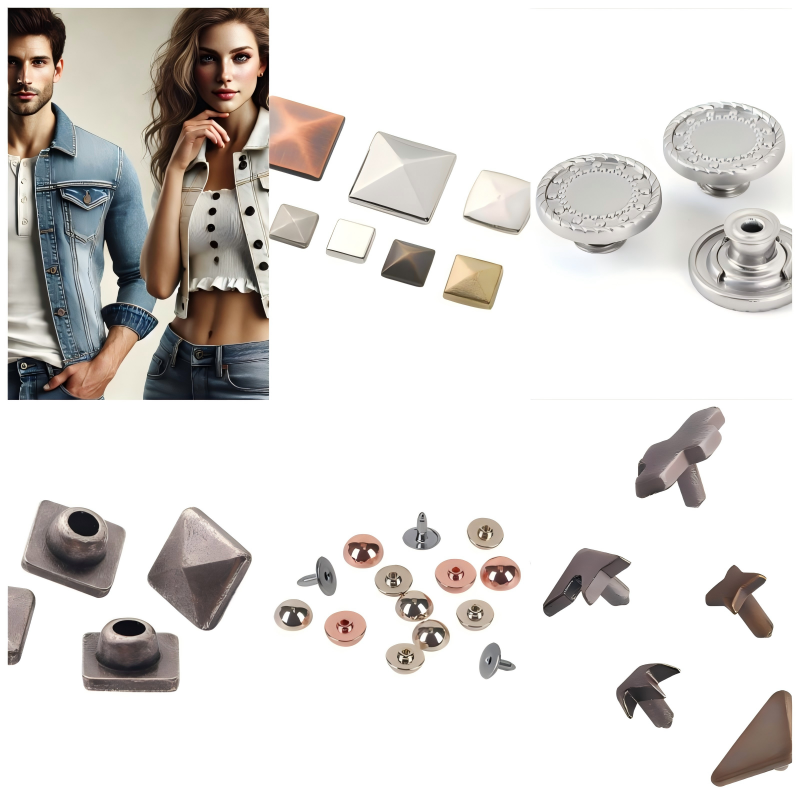Denim Jeans and the Hardware
High-Quality English Copy for Denim Jeans Hardware: Rivets, Jean Buttons, and Tack Buttons
Denim jeans have evolved from simple workwear to a universal fashion staple, beloved worldwide for their versatility, durability, and timeless appeal. Essential to the iconic look and rugged build of denim jeans are the hardware components that bring durability and style. Among the most crucial of these are rivets, jean buttons, and tack buttons, each serving both functional and aesthetic purposes.
Rivets: Reinforcing Strength and Style
Rivets are perhaps the most distinctive feature of denim jeans, instantly recognizable by their metallic finish and strategic placement. Initially developed to reinforce areas of high tension, such as pocket corners, rivets prevent the denim fabric from tearing or fraying. Rivets are made from durable metals like copper, brass, or zinc alloy, providing both strength and corrosion resistance, essential for garments that often see heavy wear and multiple washes.
Beyond functionality, rivets contribute significantly to the classic denim aesthetic. Their subtle metallic shine adds a rugged charm, making them both a structural and decorative element. Modern jeans manufacturers often personalize rivets with their brand name or logo, ensuring every pair reflects their craftsmanship and dedication to quality. Rivets are especially valued in premium denim, where they reflect attention to detail and enhance the jeans’ durability.
Jean Buttons: Essential Fasteners with Fashion Appeal
Jean buttons, also known as waistband buttons, are vital in both function and form. Positioned at the waistband to secure jeans, these buttons are typically designed to withstand repeated use, offering strong fastening without compromising on style. Jean buttons are made from robust materials such as copper, aluminum alloy, or steel, and are frequently coated to match the jeans' aesthetic, whether through matte finishes for a classic look or polished metallic sheens for modern appeal.
For premium brands, jean buttons are a prime opportunity for subtle branding. Manufacturers often engrave or emboss their logo on the button face, reinforcing the brand identity and adding an element of authenticity. High-quality jean buttons are designed to resist tarnishing and maintain their appearance over time, ensuring they remain a standout feature of the jeans for years.
Tack Buttons: The Perfect Blend of Strength and Elegance
Tack buttons, commonly referred to as snap buttons, are another essential component of high-quality denim jeans. Positioned primarily on waistbands, tack buttons work with rivets to provide stability and durability to the jeans’ fastening points. Unlike traditional buttons, tack buttons are two-piece mechanisms, often consisting of a decorative top piece (cap) and a metal tack on the inside, which is pressed together to form a strong, non-detachable button.
Tack buttons are designed with durability in mind, capable of withstanding frequent handling and high stress. Many are crafted from metals like zinc, steel, or copper, which can be finished in various ways to complement the overall style of the jeans, from brushed antique looks to shiny, polished designs. High-end jeans may feature tack buttons with custom engravings or special textures, enhancing the jeans’ visual appeal while reinforcing the brand’s commitment to quality.
Choosing the Right Hardware for High-Quality Denim Jeans
For denim brands, selecting the right combination of rivets, jean buttons, and tack buttons is essential to create jeans that not only look good but also stand up to the demands of everyday wear. Premium hardware components reflect the brand’s focus on quality, while durable materials and finishes ensure that jeans remain stylish and functional over time.
In sum, the hardware on denim jeans — from rivets to jean buttons and tack buttons — plays a fundamental role in the jeans’ overall quality and appeal. Whether enhancing strength, adding decorative flair, or showcasing brand identity, each hardware piece contributes to the enduring popularity and resilience of denim jeans. High-quality rivets, buttons, and tacks are the unsung heroes of every well-made pair, combining to create an iconic garment that has stood the test of time and remains an essential in wardrobes worldwide.
Ensuring Hardware Quality and Preventing Corrosion
The quality of the hardware used in denim jeans is paramount to their longevity and performance. Here are some key considerations and practices to ensure the hardware remains in top condition:
Material Selection:
The choice of materials for the hardware is crucial. Metals like copper, brass, and stainless steel are preferred due to their natural resistance to rust and corrosion. Additionally, many manufacturers use alloys specifically designed to resist tarnishing and wear over time.Plating and Coating:
To further protect the hardware from corrosion and oxidation, manufacturers often apply protective coatings or plating. For example, nickel plating is commonly used on buttons and zippers to create a barrier against moisture and air, which are primary causes of rust. Anodizing is another technique used on aluminum components to increase their resistance to corrosion and wear.Quality Control:
Rigorous quality control processes are essential to ensure that the hardware meets the required standards. This includes testing the hardware for strength, durability, and resistance to corrosion. Manufacturers often conduct salt spray tests and other accelerated aging tests to simulate long-term exposure to harsh environments, ensuring the hardware can withstand everyday wear and tear.Proper Installation:
Even high-quality hardware can fail if not properly installed. Ensuring that rivets, buttons, and zippers are securely attached to the denim fabric is essential for preventing premature wear or failure. Precision in the placement and securing of these components is key to maintaining the integrity of the jeans.Maintenance and Care:
End-users can also play a role in preserving the hardware on their denim jeans. Regular cleaning, avoiding harsh detergents, and ensuring the jeans are dried thoroughly can help prevent the hardware from corroding. For those living in humid climates or near saltwater, additional care may be needed to protect the metal components from accelerated oxidation.
In summary, the hardware used in denim jeans, such as rivets, buttons, and zippers, is integral to both the function and style of the garment. Ensuring the quality of these components through careful material selection, protective coatings, and stringent quality control processes is crucial for maintaining the durability and appearance of the jeans. By understanding the importance of high-quality hardware and taking steps to prevent corrosion and oxidation, manufacturers and consumers alike can ensure that denim jeans continue to stand the test of time.




